Intel to Launch Next-Gen Sapphire Rapids Xeon with High Bandwidth Memory
by Dr. Ian Cutress on June 28, 2021 12:00 PM EST- Posted in
- CPUs
- Intel
- Xeon
- HBM
- Xeon Scalable
- Sapphire Rapids
- SPR-HBM
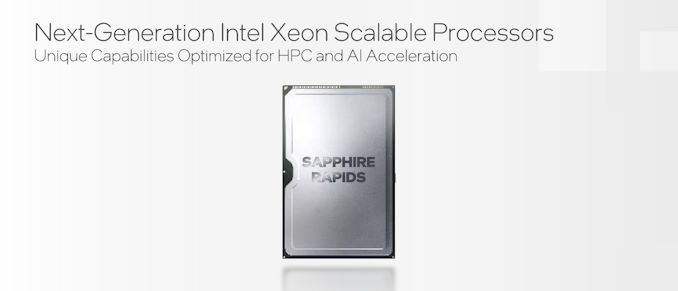
As part of today’s International Supercomputing 2021 (ISC) announcements, Intel is showcasing that it will be launching a version of its upcoming Sapphire Rapids (SPR) Xeon Scalable processor with high-bandwidth memory (HBM). This version of SPR-HBM will come later in 2022, after the main launch of Sapphire Rapids, and Intel has stated that it will be part of its general availability offering to all, rather than a vendor-specific implementation.
Hitting a Memory Bandwidth Limit
As core counts have increased in the server processor space, the designers of these processors have to ensure that there is enough data for the cores to enable peak performance. This means developing large fast caches per core so enough data is close by at high speed, there are high bandwidth interconnects inside the processor to shuttle data around, and there is enough main memory bandwidth from data stores located off the processor.
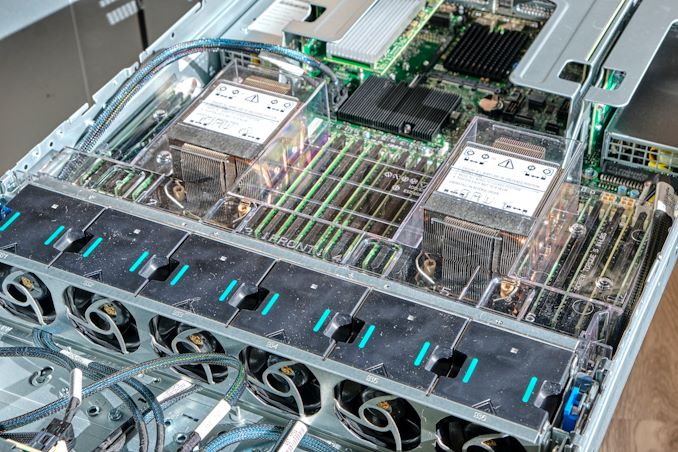
Our Ice Lake Xeon Review system with 32 DDR4-3200 Slots
Here at AnandTech, we have been asking processor vendors about this last point, about main memory, for a while. There is only so much bandwidth that can be achieved by continually adding DDR4 (and soon to be DDR5) memory channels. Current eight-channel DDR4-3200 memory designs, for example, have a theoretical maximum of 204.8 gigabytes per second, which pales in comparison to GPUs which quote 1000 gigabytes per second or more. GPUs are able to achieve higher bandwidths because they use GDDR, soldered onto the board, which allows for tighter tolerances at the expense of a modular design. Very few main processors for servers have ever had main memory be integrated at such a level.
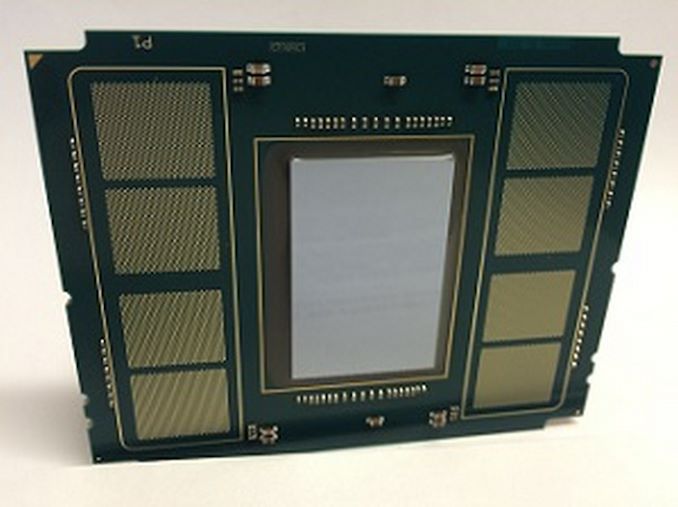
Intel Xeon Phi 'KNL' with 8 MCDRAM Pads in 2015
One of the processors that used to be built with integrated memory was Intel’s Xeon Phi, a product discontinued a couple of years ago. The basis of the Xeon Phi design was lots of vector compute, controlled by up to 72 basic cores, but paired with 8-16 GB of on-board ‘MCDRAM’, connected via 4-8 on-board chiplets in the package. This allowed for 400 gigabytes per second of cache or addressable memory, paired with 384 GB of main memory at 102 gigabytes per second. However, since Xeon Phi was discontinued, no main server processor (at least for x86) announced to the public has had this sort of configuration.
New Sapphire Rapids with High-Bandwidth Memory
Until next year, that is. Intel’s new Sapphire Rapids Xeon Scalable with High-Bandwidth Memory (SPR-HBM) will be coming to market. Rather than hide it away for use with one particular hyperscaler, Intel has stated to AnandTech that they are committed to making HBM-enabled Sapphire Rapids available to all enterprise customers and server vendors as well. These versions will come out after the main Sapphire Rapids launch, and entertain some interesting configurations. We understand that this means SPR-HBM will be available in a socketed configuration.
Intel states that SPR-HBM can be used with standard DDR5, offering an additional tier in memory caching. The HBM can be addressed directly or left as an automatic cache we understand, which would be very similar to how Intel's Xeon Phi processors could access their high bandwidth memory.
Alternatively, SPR-HBM can work without any DDR5 at all. This reduces the physical footprint of the processor, allowing for a denser design in compute-dense servers that do not rely much on memory capacity (these customers were already asking for quad-channel design optimizations anyway).
The amount of memory was not disclosed, nor the bandwidth or the technology. At the very least, we expect the equivalent of up to 8-Hi stacks of HBM2e, up to 16GB each, with 1-4 stacks onboard leading to 64 GB of HBM. At a theoretical top speed of 460 GB/s per stack, this would mean 1840 GB/s of bandwidth, although we can imagine something more akin to 1 TB/s for yield and power which would still give a sizeable uplift. Depending on demand, Intel may fill out different versions of the memory into different processor options.
One of the key elements to consider here is that on-package memory will have an associated power cost within the package. So for every watt that the HBM requires inside the package, that is one less watt for computational performance on the CPU cores. That being said, server processors often do not push the boundaries on peak frequencies, instead opting for a more efficient power/frequency point and scaling the cores. However HBM in this regard is a tradeoff - if HBM were to take 10-20W per stack, four stacks would easily eat into the power budget for the processor (and that power budget has to be managed with additional controllers and power delivery, adding complexity and cost).
One thing that was confusing about Intel’s presentation, and I asked about this but my question was ignored during the virtual briefing, is that Intel keeps putting out different package images of Sapphire Rapids. In the briefing deck for this announcement, there was already two variants. The one above (which actually looks like an elongated Xe-HP package that someone put a logo on) and this one (which is more square and has different notches):
There have been some unconfirmed leaks online showcasing SPR in a third different package, making it all confusing.
Sapphire Rapids: What We Know
Intel has been teasing Sapphire Rapids for almost two years as the successor to its Ice Lake Xeon Scalable family of processors. Built on 10nm Enhanced SuperFin, SPR will be Intel’s first processors to use DDR5 memory, have PCIe 5 connectivity, and support CXL 1.1 for next-generation connections. Also on memory, Intel has stated that Sapphire Rapids will support Crow Pass, the next generation of Intel Optane memory.
For core technology, Intel (re)confirmed that Sapphire Rapids will be using Golden Cove cores as part of its design. Golden Cove will be central to Intel's Alder Lake consumer processor later this year, however Intel was quick to point out that Sapphire Rapids will offer a ‘server-optimized’ configuration of the core. Intel has done this in the past with both its Skylake Xeon and Ice Lake Xeon processors wherein the server variant often has a different L2/L3 cache structure than the consumer processors, as well as a different interconnect (ring vs mesh, mesh on servers).
Sapphire Rapids will be the core processor at the heart of the Aurora supercomputer at Argonne National Labs, where two SPR processors will be paired with six Intel Ponte Vecchio accelerators, which will also be new to the market. Today's announcement confirms that Aurora will be using the SPR-HBM version of Sapphire Rapids.
As part of this announcement today, Intel also stated that Ponte Vecchio will be widely available, in OAM and 4x dense form factors:
Sapphire Rapids will also be the first Intel processors to support Advanced Matrix Extensions (AMX), which we understand to help accelerate matrix heavy workflows such as machine learning alongside also having BFloat16 support. This will be paired with updates to Intel’s DL Boost software and OneAPI support. As Intel processors are still very popular for machine learning, especially training, Intel wants to capitalize on any future growth in this market with Sapphire Rapids. SPR will also be updated with Intel’s latest hardware based security.
It is highly anticipated that Sapphire Rapids will also be Intel’s first multi compute-die Xeon where the silicon is designed to be integrated (we’re not counting Cascade Lake-AP Hybrids), and there are unconfirmed leaks to suggest this is the case, however nothing that Intel has yet verified.
The Aurora supercomputer is expected to be delivered by the end of 2021, and is anticipated to not only be the first official deployment of Sapphire Rapids, but also SPR-HBM. We expect a full launch of the platform sometime in the first half of 2022, with general availability soon after. The exact launch of SPR-HBM beyond HPC workloads is unknown, however given those time frames, Q4 2022 seems fairly reasonable depending on how aggressive Intel wants to attack the launch in light of any competition from other x86 vendors or Arm vendors. Even with SPR-HBM being offered to everyone, Intel may decide to prioritize key HPC customers over general availability.
Related Reading
- SuperComputing 15: Intel’s Knights Landing / Xeon Phi Silicon on Display
- A Few Notes on Intel’s Knights Landing and MCDRAM Modes from SC15
- Intel Announces Knights Mill: A Xeon Phi For Deep Learning
- Intel Begins EOL Plan for Xeon Phi 7200-Series ‘Knights Landing’ Host Processors
- Knights Mill Spotted at Supercomputing
- The Larrabee Chapter Closes: Intel's Final Xeon Phi Processors Now in EOL
- Intel’s 2021 Exascale Vision in Aurora: Two Sapphire Rapids CPUs with Six Ponte Vecchio GPUs
- Intel’s Xeon & Xe Compute Accelerators to Power Aurora Exascale Supercomputer
- Hot Chips 33 (2021) Schedule Announced: Alder Lake, IBM Z, Sapphire Rapids, Ponte Vecchio
- Intel’s Full Enterprise Portfolio: An Interview with VP of Xeon, Lisa Spelman
- What Products Use Intel 10nm? SuperFin and 10++ Demystified
- Intel 3rd Gen Xeon Scalable (Ice Lake SP) Review: Generationally Big, Competitively Small


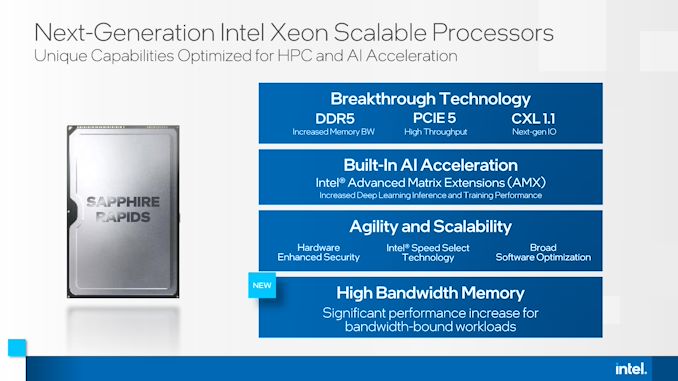
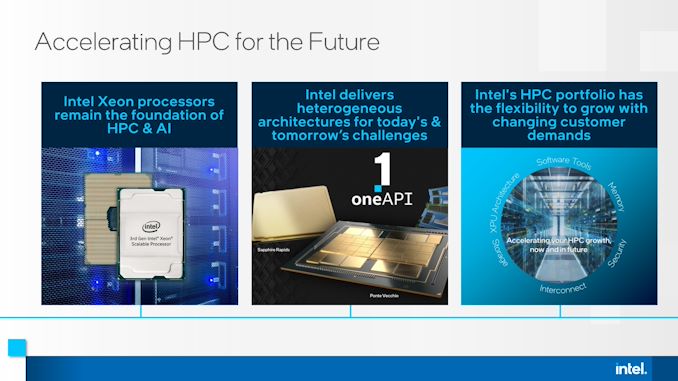

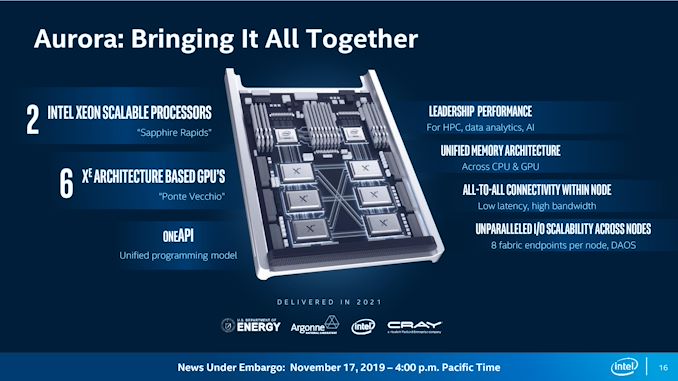








149 Comments
View All Comments
Oxford Guy - Thursday, July 8, 2021 - link
I will also add that your rebuttal attemp regarding protecting the optical media completely flies in the face of your attempt to justify ‘consoles’ on the basis of better build quality and ease of use.I also already pointed out the sad sorry cold hard fact that the ‘console’ peddlers are peddling the same defective joystick mechanism. Extremetech covered that.
If you’re going to try to make arguments take more time to make them hold some water. Reality is that software DRM doesn’t increase hardware build quality nor differentiate that hardware at all, other than the existence of so much redundancy reduces the incentive 3rd parties have to try to compete. The market is diluted.
Parasitic redundancy is a positive for certain corporations and their investors. It’s entropy for consumers.
mode_13h - Thursday, July 8, 2021 - link
> If you’re going to try to make arguments take more time to make them hold some water.If you're going to reject my points, then simply reject them. You don't need to blame me for not making a better case, when you were probably going to reject them no matter what.
I make points to be considered. I don't pretend they will change anyone's mind who's already staked out a position. When is the last time you saw that, on the Internet?
mode_13h - Thursday, July 8, 2021 - link
> Your other claims, like build quality, are total nonsense.I understand the point was rather vague, so I'll explain. If you build a mini-ITX PC with comparable horsepower to modern consoles, the fact is that they don't ship as well and the cases have to be beefed up to support the PC's expandability. The mechanical (and thermal) design of consoles is optimized for what they are, saving weight, cost, size, packing material, and damage in transit.
Let's say Sony and MS both supported the same OS, APIs, and games as PCs. So, you could run any game on any of the three. They might cost a little more, because they can no longer be sold at a slight loss, but they would still be cheaper than a PC with comparable specs.
> DRM that is parasitic for consumers.
PC games have DRM, as well.
GeoffreyA - Thursday, July 8, 2021 - link
"And it's also cheaper for the horsepower you get."Quite an important point nowadays.
mode_13h - Wednesday, July 7, 2021 - link
> Sony and MS churn out consoles to make money; AMD saw an opportunityAnd let's not forget that Sony and MS were going to make consoles no matter what. And those consoles were going to compete for wafer supply. So, that's just another reason that whole point falls flat.
mode_13h - Wednesday, July 7, 2021 - link
> Samsung was caught for hiring astroturfers.Sounds interesting. Source?
> explain how the existence of the ‘consoles’ as they are today ...
> are not more harmful to the PC gamer’s wallet
I don't understand this argument. If you could magically remove the silicon demands of consoles over night, then we'd certainly see chip prices drop, for a while. However, that's not what would actually happen, if there were never consoles. What would happen is that there'd be even more demand for gaming PCs, which use more silicon and other components than consoles. So, by eliminating the console tier, you could actually just increase silicon demand.
> Explain how having four artificial walled software gardens is in the interest of the consumer
Yeah, that's not great. I don't like walled gardens on phones, cloud, or elsewhere, either. Seems to me like more of an indictment of modern tech than specific to consoles, however.
> Explain how having just one 1/2 companies producing PC gaming GPUs
> has led to a healthy PC gaming platform
AMD gets valuable input & feedback from Sony and MS that influence their development. The market for console gaming also incentivizes them to continue their GPU development beyond the profit they make from PC gamers. It's easier to make those investments when you have a fairly stable income stream, which the PC GPU market hasn't been. I don't know how long you've been following PC GPUs, but it's very much been a tale of boom and bust cycles.
> than one that falls prey to mining, wafer unavailability,
That's the whole tech industry.
> lack of competitiveness
That's the overhang of AMD's multiple generations of uncompetitive CPUs, IMO. AMD was in bad financial shape for several years, leading to lack of investment and innovation. RDNA is the first we saw of the newly-invigorated AMD, from their graphics division.
The problem is that Nvidia is moving much faster than Intel's CPU division, so it will be harder for AMD to surpass Nvidia than it was for Zen3 to beat Intel. Still, they're making very strong progress.
> None of this is difficult to comprehend
What's difficult to comprehend is how you think the world would be so much better without consoles. It would cause more supply problems and higher prices, and those who couldn't pay would be stuck gaming on phones and tablets.
It's also hard to see why you're tilting at windmills, like this. Nobody has the power to simply make consoles go away. I could understand focusing on the walled garden thing. That's your strongest argument and it's conceivable that governments could actually force some meaningful change, there.
> Suffice to say that Linux with Open GL, Vulkan, and the ITX form factor ...
> it’s so obvious that apparently no one can be bothered to see it.
Valve has invested a lot into development of the Linux graphics stack, but I doubt it's paid off, for them. I mean, it works as a little bit of a threat against MS, but the idea of steam boxes as an alternative console hasn't been a thing for quite some time. Of course, a lot of people have gaming PCs hooked up to their living room TV, so it's not as if people don't know that it's possible. Nvidia has even sold GSync Ultimate monitors that are essentially gaming TVs.
mode_13h - Wednesday, July 7, 2021 - link
Regarding silicon supply, there's another point to consider and that's how often PC gamers do upgrades vs. console users. If you've got a console, there's no sense upgrading it until the next generation comes out. Even the half-steps we saw in the last generation probably garnering a relatively small number of upgrades.In PC gaming, 7 years is multiple lifetimes to be using the same graphics card, if not also the same CPU. So, that's another way that forcing more people into PC gaming would just put even more strain on the silicon supply chain.
Oxford Guy - Thursday, July 8, 2021 - link
‘Yeah, that's not great. I don't like walled gardens on phones, cloud, or elsewhere, either. Seems to me like more of an indictment of modern tech than specific to consoles, however.’Specious hand waiving.
1. Parasitic redundant walled gardens are the ONLY defining quality of consoles since Jaguar.
2. The end.
Oxford Guy - Thursday, July 8, 2021 - link
Since I know you won’t comprehend this I will explain it even more.A console is hardware that is very different from common x86 hardware (home PCs). That is its defining quality. That hardware difference stems from the hardware needing to be different in order to deliver the console gaming experience.
The PS3 you mentioned erroneously — with its (sadly very harvested) Cell CPU that was greatly inferior to an x86 or PPC desktop machine for general-purpose computing/AI — versus streaming, the thing it was optimized for — and Blu-Ray, the other oddity about the PS3 hardware — was the last hurrah for the console. It’s dead, Jim.
What’s lacking flesh is the horse all the specious archaic arguments about the ‘consoles’ rode in on. Jaguar junk came out a long time ago. The facts have been clear for much longer than anyone should need to have to comprehend the state of affairs.
GeoffreyA - Thursday, July 8, 2021 - link
Oxford Guy, I would say that consoles allow one to play games on a TV and not worry about computers. Arguably, they look neater and are smaller. And the game is guaranteed to work. That's differentiation enough, from the consumer's point of view. (Whether they're x86 or not, is more of an implementation detail.) Many folk have a preference for them, too, having grown up on the Xbox or PS. Of course, we computer enthusiasts hold to the idea that PC gaming is number one, which is just a preference, like theirs. Yes, consoles are computers tricked up in simple garb, locked up in DRM jail, but if the consumer sees them as accessible gaming devices in the sitting-room, they will be sold.